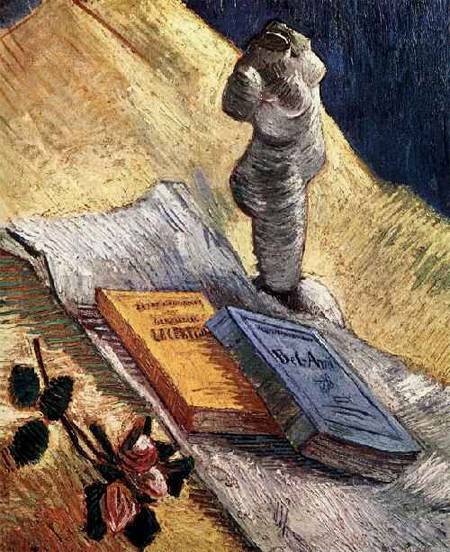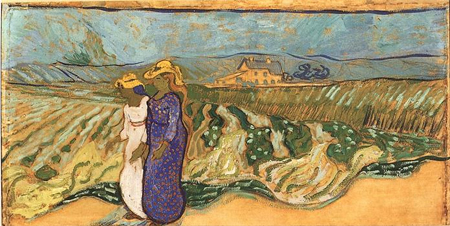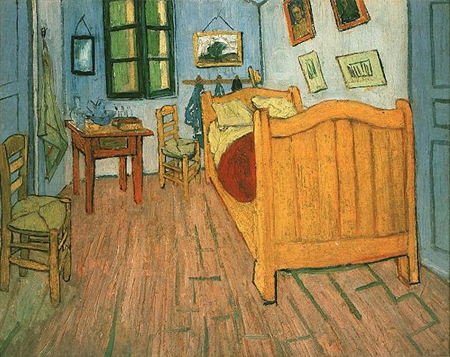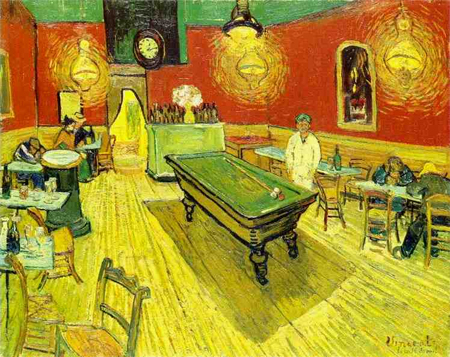Looking for imaginative interpretations of perspective by Vincent van Gogh, I came across his Still Life with Plaster Statuette, a Rose and Two Novels. It reminded of someone else’s still life posted earlier on A&P that was critiqued for grapes that seemed to be sliding of an underlying cloth.

I love Two Women Crossing the Fields because of how the women are integrated into the flow of the landscape.

Finally, I found what I was looking for – Vincent’s Bedroom in Arles,
…to be suggestive here of rest or of sleep in general. In a word, looking at the picture ought to rest the brain, or rather the imagination.

In his letter 554, van Gogh further wrote that
The shadows and the cast shadows are suppressed; it is painted in free flat tints like the Japanese prints. It is going to be a contrast to, for instance, the Tarascon diligence and the night café.
Here is The Night Cafe in the Place Lamartine in Arles.

Do you have any comments on VVG’s use of perspective and shadings?

Birgit:
Do you know the date of “Two Women”? Sure looks like Gauguin was visiting at the time, considering the way that the figures are done.
Interesting the perspectives in this painting: the planted rows ahead of the figures recede in an orderly fashion, while those in the wake of the figures are a jumble. Makes me think of the turbulence in the wake of a boat or airplane. If I remember, Van Gogh had two sisters who suffered from mental disorders with one or both committing suicide. Is there any reason to draw a connection? That is, if I remember correctly. The orange-brown hair of the nearer figure falls down her back in anticipation of what follows: either as a sympathetic movement in the composition or as a cause.
I would risk life and limb to save The Night Cafe from a fire. Since you bring up shadings, allow me to mention shadows. For all of its sense of gauze, this painting is abrupt in the way things are presented: four hard sources of light are above a brick of a pool table. The table is so anchoring that it is given a single albeit modulated shadow. This departure from optics may represent a kinship connection between the table and the floor as they share a common characteristic: the table is host to a potential scattering of billiard balls and the floor of the cafe to a temporary population of clients on temporary furniture who themselves may be hitting on each other.
The still life makes me want to go back and look at something related by Cezanne.
Birgit,
Thanks for showing especially those first two, which I didn’t know. I agree the still life doesn’t look to be on a level table. I don’t think that Van Gogh is even close to as good at drawing (i.e. as capable of realistic rendering) as Hanneke. The particular way his art deviates from reality is part of what makes it fascinating. For example, I do not find the bedroom very restful, despite the quieter color scheme: the distortions make it feel unstable. Was that quote from Van Gogh himself?
The colors in the first two paintings seem so subdued and so unlike van Gogh, I think. The perspective in the first has the familiar nauseating whirl he could create (and what is stable and solid in this world anyway, right?)
I think it’s interesting that no person in the Night Cafe painting casts a shadow. One could write pages on this one painting.
I often wonder what van Gogh was really saying with this painting of his bedroom as he draws the viewer’s eyes to his bed with his self portrait and Gaugin’s portrait on the wall above it. Sex and death and the lonlieness in between, perhaps.
Jay,
The Two Women Crossing the Fields were painted in 1890. Gauguin’s influence could explain why I like them. I am a fan of Gauguin’s women.
I love your analysis of the planted rows. What a great idea to show the disruption of an organized landscape to depict the mentality of the people walking by.
I did mean shadows rather than shadings.
I was also struck by what you call the ‘anchoring’ of the table. I had not realized that the shadow of the table was not realistic. For all its apparent seaminess – booze and people hanging over the table – the picture exudes stability.
You and June have been talking about Cezanne. So far, I put off studying him. I thought that I was not quite ready because I am only just learning about perspective.
Birgit,
Funny that you mention the great van Gogh in this post. I was watching Simon’s series “Power of Art” last night (TIVOed it) and the first episode was on van Gogh and I thoroughly enjoyed every minute.
Vincent’s use of perspective is a little distorted when it came to the strict rational use of perspective and I suspect he was rebelling. In fact it is apparent from the bedroom scene above that from a pure perspective study, it would suggest a trapezoidal room when in reality I would suspect it was a regular rectangle. Use of distortion of this kind was a form of rebellion and a means to chart ones own course in those troubled times.. I think.
Tree,
I think it is amazing that you managed to attribute the portraits in his bedroom (guess it must have been mentioned in correspondence to Theo).
Steve,
I do not find the bedroom very restful
I was also intrigued by van Gogh’s interpretation of his bedroom painting. I had searched for it on the web because I also had remembered it as ‘unstable’.
In his letter 554 van Gogh further states that
Like you, I don’t find his picture restful.
Tree,
I was awed clicking through van Gogh’s pictures on Vincent . and I copied many pictures. I then pared it down to the four that I show here not to overwhelm us. Only today, I am beginning to understand more about my choices. I had not realized that the people were missing shadows in the Night Cafe. That explains why they look insubstantial. If you click through his pictures on the Vincent website, you find others with mute colors . Thanks for explaining about the pictures above the bed.
One of the books in his still life is Bel-Ami by Maupassant that I read in French (no big deal speaking French when your German high school sends you to France). Can you make out the title of the other book?
It reminded me of someone else’s still life posted earlier on A&P that was critiqued for grapes that seemed to be sliding off an underlying cloth.
I think whenever you create something, you also establish a context, and a set of expectations that the viewer will have.
In an otherwise realistic painting of a scene (like Hanneke’s grapes), anything that is inconsistent with the perceptual realism established by the rest of the image will stick out as a flaw. On the other hand, nothing in Van Gogh’s paintings leads us to expect accurate persective and color. If anything, it is his direct emotional response to his subject matter that I think we find compelling. If you put Hanneke’s beautifully rendered vase of grapes into Van Gogh’s still life, it is the grapes that would seem incorrect.
David,
I am learning so much today. You are right in saying that you also establish a context, and a set of expectations that the viewer will have.
I am a fan of Hanneke’s oil paintings and I love looking at two of them that hang on my walls.
In the post, I did not explain my feelings about one of Hanneke’s grape paintings. There seemed to be something unstable in an earlier version of this painting that I found very attractive. I actually have a photograph of that earlier version. Hanneke made her photograph of it available and Steve printed and framed it for me.
I am a perspective junky!
Hi Birgit, I’m not sure about the book and now I’m not so sure about the paintings! I did a quick Google and found that there are 3 versions of this painting in oil and 2 drawings. In the version you show here, the paintings are of his friends Milliet and Bloch. In another version, the paintings are a self portrait and what looks like the woman who posed for La Berceuse.
I’ll be the first to admit my memory can be shaky at times, but in a class devoted to van Gogh and Gauguin, I thought I’d been told the portraits were of Van Gogh and Gauguin and the work was sent to Gauguin before he came to Arles. I know they exchanged portraits and apparently van Gogh sent Gauguin a sketch of the room.
I’ll have to read up on this over the weekend :-)
Tree,
Thanks for taking all that trouble. I am glad to learn about the communication between van Gogh and Gauguin.
Reading A&P is like or perhaps even better (?) than taking an art class. Many instructors, not just one.
Sunil,
Rebellion sounds good. I have been highly law-abiding in spite of saying in my application for a ‘Green Card’ in 1964 that I planned to overthrow the American Government.
The nice lady at the Munich embassy told me that I must have made a mistake and should instead say that I did not intend any overthrow. I did make that correction.
I will practise ‘rebellion’ in my drawings and paintings of perspective.
Birgit and Jay,
The Cezanne Jay was thinking of might be Still Life with Plaster Cupid (1895).
http://www.ibiblio.org/wm/paint/auth/cezanne/sl/plaster-cupid/cezanne.plaster-cupid.jpg
If you like Van Gogh’s still life perspectives, Birgit, you are ready for Cezanne. It was he who played with tilted fields and tipsy apples. Art was never the same afterward.
Yes June, that’s it. One could put these two side-by-side and have a merry old time discussing what’s different and what’s similar.